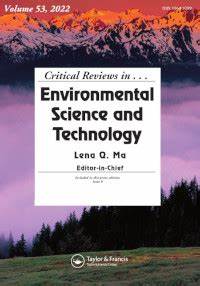Adsorption kinetics and isotherm models of heavy metals by various adsorbents: An overview
IF 11.4
1区 环境科学与生态学
Q1 ENVIRONMENTAL SCIENCES
Critical Reviews in Environmental Science and Technology
Pub Date : 2023-06-15
DOI:10.1080/10643389.2023.2221157
引用次数: 9
Abstract
Abstract Heavy metal pollution has become one of the most severe environmental issues. Adsorption is an effective method for removing heavy metals from aquatic environments. The adsorption isotherm and kinetics models can provide information on the adsorption process, maximal adsorption capacity, and mass transfer steps, which are essential to evaluate the performance of an adsorbent and to design an adsorption system. In this review, the adsorption kinetics and isotherms of heavy metals by various adsorbents were summarized and discussed in depth. First, the sources of heavy metal pollution and the adsorption technology to remove heavy metals were reviewed. The adsorption capacity of Cu, Cd, Zn, Ni, Cr, As, Fe, Hg, Co, Sr, and Cs by biosorbents (e.g. algae, agriculture waste biochar/activated carbon, and bacteria) and by abiotic adsorbents (e.g. metal–organic frameworks (MOFs), microtubes, polymers, clays, minerals, and coal) were systematically summarized. Second, the origins, basic assumptions, importance, physical meanings, and applications of the adsorption kinetics and isotherm models were discussed in depth. Third, the methods for selecting adsorption models in different conditions were explained, and the statistical parameters which can be applied to evaluate the performance of the models were illustrated. Finally, two Excel sheets are provided for solving the adsorption models, which are available in Supplementary Information. This review article will deepen the understanding of the interaction between heavy metals and adsorbents and facilitate the development of adsorptive technology for heavy metal removal from water and wastewater.各种吸附剂对重金属的吸附动力学和等温线模型综述
摘要重金属污染已成为最严重的环境问题之一。吸附是去除水生环境中重金属的有效方法。吸附等温线和动力学模型可以提供关于吸附过程、最大吸附容量和传质步骤的信息,这对于评估吸附剂的性能和设计吸附系统至关重要。本文对各种吸附剂对重金属的吸附动力学和等温线进行了综述和深入讨论。首先,综述了重金属污染的来源和吸附去除重金属的技术。系统总结了生物吸附剂(如藻类、农业废弃物生物炭/活性炭和细菌)和非生物吸附剂,如金属-有机框架(MOFs)、微管、聚合物、粘土、矿物和煤)对Cu、Cd、Zn、Ni、Cr、As、Fe、Hg、Co、Sr和Cs的吸附能力。其次,深入讨论了吸附动力学和等温线模型的起源、基本假设、重要性、物理意义和应用。第三,解释了在不同条件下选择吸附模型的方法,并说明了可用于评估模型性能的统计参数。最后,提供了两张Excel表来求解吸附模型,可在补充信息中获得。这篇综述文章将加深对重金属与吸附剂相互作用的理解,并有助于开发从水中和废水中去除重金属的吸附技术。
本文章由计算机程序翻译,如有差异,请以英文原文为准。
求助全文
约1分钟内获得全文
求助全文
来源期刊
CiteScore
27.30
自引率
1.60%
发文量
64
审稿时长
2 months
期刊介绍:
Two of the most pressing global challenges of our era involve understanding and addressing the multitude of environmental problems we face. In order to tackle them effectively, it is essential to devise logical strategies and methods for their control. Critical Reviews in Environmental Science and Technology serves as a valuable international platform for the comprehensive assessment of current knowledge across a wide range of environmental science topics.
Environmental science is a field that encompasses the intricate and fluid interactions between various scientific disciplines. These include earth and agricultural sciences, chemistry, biology, medicine, and engineering. Furthermore, new disciplines such as environmental toxicology and risk assessment have emerged in response to the increasing complexity of environmental challenges.
The purpose of Critical Reviews in Environmental Science and Technology is to provide a space for critical analysis and evaluation of existing knowledge in environmental science. By doing so, it encourages the advancement of our understanding and the development of effective solutions. This journal plays a crucial role in fostering international cooperation and collaboration in addressing the pressing environmental issues of our time.

 求助内容:
求助内容: 应助结果提醒方式:
应助结果提醒方式:


